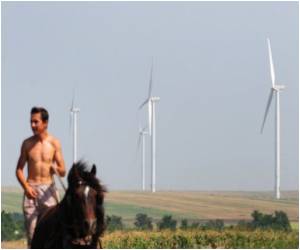
Environmental groups, energy experts and some politicians increasingly point to offshore wind farms as a viable alternative to coal, adding that it could have more economic upside than a planned investment in nuclear power.
Germany, the continent's largest economy, is looking to buy more clean energy, and with little space left to generate added wind power domestically, some in Poland believe they can capitalise on that opportunity as well.
"Germany closing down their nuclear facilities by 2022 will generate a big take-off for offshore wind energy," said Thomas Gaardbo, vice president of GSG Towers, an offshoot of the Gdansk Shipyard that is driving the wind power initiative.
Germany's onshore wind market is saturated, Gaardbo argued, adding that he thinks "the only real development that can happen" there is in offshore.
"We're trying to position ourselves for that offshore market," he said.
Advertisement
Conditions at Gdansk have changed since 1980, when anti-communist crusader Lech Walesa led a strike over price increases and job losses that culminated in the creation of Solidarity, the first independent trade union in the then-Soviet bloc.
Advertisement
Gdansk, shipyard officials say, also has the highly-skilled welders needed to build the 270-tonne, 100 metres (328 feet) turbines.
Poland's Institute for Renewable Energy (IEO) recently urged the government to invest in offshore wind farms instead of forging ahead with plans to build the country's first nuclear power facility.
The nuclear scheme, which aims to build an operational plant by 2020, requires a 25 billion-euro (35 billion-dollar) investment.
The IEO, in a study commissioned by the environmental advocacy group Green Peace, argued that investing in a 5.7 gigawatt wind farm would be cheaper, safer and should create more jobs.
IEO chief Grzegorz Wisniewski noted the plethora of wind farms in Germany, Denmark, the Netherlands, France and Spain, compared to just a handful of sites in Poland.
"In Poland, you just have a tiny smattering of onshore wind farms and none offshore," said Wisniewski, noting its entire installed wind capacity totals just 1.5 gigawatts.
"Now 90 percent of our electrical energy is based on coal so we're looking for options ranging from the exotic like nuclear or shale gas, to proven renewable sources," he said, pointing to wind energy as one of the best choices.
"It's a proven technology for immediate use and as a large country, Poland has huge untapped wind energy resources," he added.
Tomasz Koprowiak, the mayor of Kisielice in northern Poland, said the wind power industry has been a blessing for the people in his poor, rural farming community.
Kisielice's wind farm -- whose 39 turbines with a 65 megawatt capacity account for five percent of Poland's total wind energy production -- generates more than enough power to service the town's 6,500 residents.
"We've never had any protests against turbines here," he said, adding that local farmers are more than happy to lease land to windmill operators.
Koprowiak wants to expand to a 140-megawatt capacity, and argued that money designated for nuclear investment should be redirected to other areas, including wind, biogas and solar.
Gdansk Shipyard entrepreneur Mieczyslaw Twardowski, who heads the Baltex company that is working with Poland's Maritime Institute to develop more offshore wind sites, agreed completely.
"If we're talking about the big picture, nuclear energy isn't feasible," he argues. "With nuclear, we're dumping the danger and cost of de-commissioning on future generations."
Source-AFP







